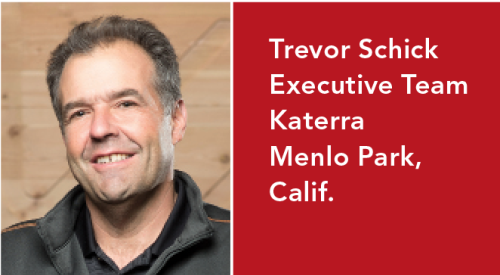A silver lining edges the black cloud over the housing industry. The slowdown in sales and site operations presents an opportunity for builders, trade contractors, manufacturers and suppliers to catch a breath, step back and look closely at how materials and products are purchased, delivered to and assembled in homes. Some bold contrarians are finding ways that better match purchasing methods and the supply chain to the realities of production building in today's market. With fewer houses to build, they have a chance to reshape a home building company — or even an entire supply chain with new systems, processes and partners — without jeopardizing operations.
The largest builders began to clamor for supply chain change more than a decade ago, as growth by acquisition allowed the huge, publicly traded giants of production building to expand into national operations — even though building materials distribution and logistics still dictate that housing is a local business. (Lumber and most of the products that go into a new home are still delivered to building sites through long, archaic distribution channels suited to an industry of small, local contractors.)
Home builders such as Pulte, Centex and Toll Brothers developed national purchasing programs to leverage their size and even their own component manufacturing capabilities to streamline on-site construction operations. In 2004, Pulte even launched a bold experiment in supply chain intrusion in the desert markets of Phoenix, Tucson and Las Vegas, first launching a joint venture with its largest trade partner, Pratte Development (a huge framing and concrete subcontractor), then purchasing the company and taking the entire turnkey operation in-house a year later as Pulte Building Systems.
Even then, Pulte admitted the viability of the move was tied to the high building volume of its desert divisions, which built thousands of homes each year. Today, with all those markets in retreat, Pulte may regret the Pratte deal. But an alternative approach designed to accomplish many of the things Pulte sought — reduced costs, cycle times and better quality through integration of all the trades building the shell of a home — is now available to production builders across the country through a construction services company that sprang from the same desert.
Selectbuild Integrates Turnkey Materials, LaborIn June 2006, publicly-traded Building Materials Holding Corp., the San Francisco-based parent of building materials distributor BMC West, launched SelectBuild — an integrated construction services firm with its roots in Phoenix turnkey framer Knipp Brothers Industries. It has distribution capabilities that now allow it to offer installed services in California, Arizona, Nevada, Illinois, Florida and the Mid-Atlantic states of Delaware, Maryland and Virginia.
"Our business model offers large builders a turnkey approach to managing multiple trades on the job site," says SelectBuild President Michael Mahre, "and the integrated construction logistics to support the full process. We manage the flow of materials to the job site as well as the trades that perform the installation work."
The goal is to provide large production builders with faster build times and improved quality control. Mahre claims savings in build times ranging from 10 percent to 50 percent, depending on the number of trades involved and depth of integration achieved.
Mahre admits SelectBuild's clients are now focused on cutting costs, to the exclusion of virtually everything else. "They have to get their costs down to the new pricing parameters of the market," he says. "We can do that because of the scale of our operations and direct buying power we bring to the table."
The turnkey approach — where the trades provide materials and labor priced as a single purchase — is favored by builders in the West. "What we do is take the elements of turnkey that builders like and expand the approach to include multiple trades and materials, not just framing," Mahre says. "When we sit down with a builder, we explain the entire distribution process for each trade — how materials get to the job site, where all the costs lie.
"Some builders are treading on thin ice by trying to invest their own money to control portions of the supply chain," Mahre warns. "They end up investing a lot of capital, resources and effort. A better way is to contract with distribution industry professionals who can achieve competitive advantages in these areas, while the builder concentrates on core competencies such as land acquisition, product design, marketing and sales. That's what our clients do. They rely on us to be their experts on supply chain management and job site labor."
SelectBuild now has the capability to manage up to eight trades in Las Vegas. "That's our most mature integrated market," says COO (and former Pulte executive) Randy Folts. "We concentrate on the big three of foundations, framing and plumbing. If you analyze construction processes, those are where the bulk of savings can occur. But we've also added windows and trim, roofing, masonry and stucco, as well as HVAC and job site grading and trenching."
SelectBuild has now expanded its targeted builder list to include smaller, single-market firms. "We used to focus on builders who could give us projects of 200 units or more," Mahre says, "but those are now few and far between. Our projects are now getting smaller and densities are going up; 25 percent of our revenues now come from multifamily developments. We can leverage our project management skills on tight, infill sites," he says.
The firm is still strongest in western markets like Las Vegas, Phoenix and Southern California, with clients that include KB Home, Lennar and Ryland. But SelectBuild is expanding its trade list in Chicago, Florida and the Mid-Atlantic, and it's eyeing possible startups in the Twin Cities and St. Louis.
Ilevel, Pro-Build Target GiantsThe playing field is now becoming increasingly crowded with supply chain innovators seeking partner relationships with production builders — especially the big, multi-market operators with large unit volumes that create economies of scale. Among the most aggressive innovators today are iLevel, forest products giant Weyerhaeuser's distribution arm that's now uniting all the firm's builder-targeted products and services, and Pro-Build, the Denver-based national building materials distributor targeting production builders with a one-stop-shop business model similar to Home Depot's approach to the DIY market.
Pro-Build operates more than 500 lumber and building materials distribution, manufacturing and assembly centers in 40 U.S. states. The firm distributes lumber, plywood, gypsum wallboard, drywall products, millwork, trusses, roofing, siding, insulation and hardware just for starters.
"Pro-Build is backward integrating into two-step distribution," says Atlanta-based distribution industry insider Rod MacKenzie, who is now putting together his own innovative new company to target builders going into green building operations. "They're going to go directly to manufacturers, and they will build (warehouse) buildings to support their operations," he predicts. "They now have the critical mass to ship mixed truckloads from their own distribution centers."
MacKenzie predicts Pro-Build's growing capacity will soon tempt some of the public builders with their own supply chain and panel manufacturing initiatives to dump those operations. "Builders like Centex and Toll and NVR now have their own facilities where they bring in truckloads of building materials and assemble wall panels, floor trusses and roof trusses," he says. "But that's a break-even business for them at best. It's not their core competency, and the Wall Street analysts continue to hammer them to get that stuff off their balance sheets.
"Pro-Build and other distribution specialists are much better at it. Their core competency is delivering to job sites. They have the complete package: warehousing of products, assembly of components for walls, roofs and floors," MacKenzie says. "They can also do distribution services. Builders can now go to China and buy canned lights or granite countertops. They can get the stuff to the Port of Los Angeles easily, but the challenge is to get it to the job site. They are now engaging Pro-Build to take containers to their facility, break them down and ship the products to the builder's job sites.
"Pro-Build never takes ownership — they just ship it through their facility and deliver it with a normal job-pack," MacKenzie relates. "The builders are beginning to take note of people like that ... who are forward-thinking and have the ability to service their businesses. It's starting to turn heads."
MacKenzie believes the big national builders are going to get into components more than ever when the market comes back, but it may not be with products of their own manufacturing facilities. "Pro-Build is on their radar," he says.
ILevel is also aggressive. "Weyerhaeuser smells blood in the water out West," MacKenzie says. "ILevel is a combination of manufacturing and distribution that's extremely powerful, especially close to its manufacturing base, which is out West. Weyerhaeuser has strong relationships with the major players in the West. The big framers own California and iLevel is smart. They don't have to use their distribution arm. They will ship to customers large enough to take direct shipments and use their distribution arm for everybody else."
Before iLevel, Weyerhaeuser had a collection of individual, product-based businesses that each had builders as a primary market — lumber, engineered lumber, OSB and plywood panels among them. But a few years ago, the firm began listening to builder clients who explained how much easier it would be to do business with them if they could buy all products and services from one source instead of five or more. "One of the factors that led us into iLevel was the growing market share of high-production, national builders," says Scott Elston, iLevel director of national accounts. "We felt we needed to align ourselves with these growing companies."
Weyerhaeuser has core competencies in structural framing and components that are assembled on-site into a home. "We also have software, and the ability to bundle products and services," says Elston. "Eighteen months ago, we launched iLevel to meet this challenge. Will builders be willing to innovate in the midst of a housing downturn? We've found it depends on the builder — some will. They say this is the time to make changes that will pay off when the market comes back. Most of the Top 10 builders are taking a long-range view."
ILevel's approach is to collaborate with the builders within the existing distribution channel, finding innovations from both directions that take costs out of the builder's processes to the benefit of everyone. "Can we use value engineering to reduce the materials required to build a house?" Elston asks. "Do we have the right products available in every region where the builder has operations? Can they use more components to make site assembly easier and faster?"
ILevel's strategy is to market to the builder and sell to the dealers in its supply chain. The firm has the ability to meet builder needs for everything from pre-cut job packs to panelized wall sections to an installed price for turnkey operations.
Builder Partnerships Brings Pricing Clout to LocalsNot all supply chain innovations target the largest production builders. Littleton, Colo.-based management consultant and Professional Builder columnist Chuck Shinn and long-time CertainTeed executive Glenn Singer spent the last three years pulling together a cooperative organization called Builder Partnerships, with the goal to negotiate price rebates on the products smaller, local production builders use — to give 65 such companies the combined bargaining power of a Top 10 builder.
"The sweet spot of Chuck's consulting business is privately held builders averaging about 300 closings a year," says Glenn Singer. "Through the years, he noticed that those companies often didn't have good relationships with manufacturers, usually because the manufacturers were spending all their time courting the Top 50 builders in production volume. Regional and local builders had to rely on their distributors and dealers to carry the ball. We started Builder Partnerships to fill that gap."
The 65 builders across the U.S. and Canada combine to build about 20,000 homes a year, so when they speak with one voice, the manufacturers listen. Singer and 'Shinn go to the manufacturers and negotiate rebates, design center allowances, model home allowances and co-operative advertising. In return, the manufacturers get to attend builder events three times a year where they meet face-to-face with a segment of the housing industry that was heretofore unknown to them.
"One of the eye-openers for the manufacturers was learning what purchasing managers of these companies really do," Singer says, "that they are often in charge of product development, value engineering and design center operations. Another eye-opener for them was learning how involved it can get when a builder decides to change out a product — especially those that are visibly on display in the model homes. It can take six months to make such a move."
Singer notes that as the market has slowed, manufacturers have become more interested in participating in his program. "They now realize that there are a lot more of these guys than the Top 25, and each builder represents an opportunity to increase market share," Singer laughs. "Our largest builder in the group is Mercedes Homes, which closed 4,264 homes last year (Mercedes is No. 28 in PB's Giant 400)."
Builder Partnerships does all the negotiating for the builders and also handles all the tracking of product usage. "We collect the rebate money and disperse it," Singer says. "That saves the builder a lot of time and trouble. We collect an administrative fee. It's all done online; every builder and every manufacturer has its own Web site."
The group now buys about 60 different products. It doesn't negotiate prices but often acts as a conduit for communication between builder and manufacturer. "If the builder tells us he'd switch to a product on our list if he could get a forward pricing guarantee from the manufacturer, we relay the information to the manufacturer," Singer reveals. Product categories covered include plumbing fixtures, faucets, HVAC equipment, engineered lumber, siding, windows, flooring, hardware, insulation, paint, locks and garage doors. "We have to give the builders choices, so at 20,000 units a year, we promise the manufacturers we won't have more than two manufacturers per product category. When we hit 30,000 units, we'll probably have three per category," Singer says.
John Boersma, purchasing director for Olthof Homes, which will close about 300 homes this year in the northwest Indiana suburbs of Chicago, says he gets between $300 and $500 in rebates on every home he closes. "It depends on what the buyer puts into the house in options," he says. "It's much easier working on this with Builder Partnerships than it would be trying to administer a rebate program on our own. My only regret is some of the product categories not represented, but I know they're working on those."
Ed Hauck, vice president of purchasing for suburban Philadelphia builder Rouse-Chamberlain Homes, says the most important thing he gets from Builder Partnerships is not the rebates but rather the returned phone calls from senior executives of manufacturing companies. Rouse-Chamberlain will close about 100 homes this year at an average price of $350,000. Homes range from 1,800 to 3,500 square feet.
"It's hard to quantify how much that's worth when you're trying to solve a problem, but my guess would be half a percent of hard costs. ... I'd say we're saving $2,000 a house above and beyond the rebates.
"For instance, one manufacturer was waiting until he had a full load to ship to the distributor, so we weren't getting deliveries on time. That rule was OK when the market was hot, but since the slowdown, waiting for a full load put us behind. It held up construction of one house for a week. What does that cost? A phone call resolved it. I was able to arrange special shipments direct to our houses."
A recent breakthrough for the group is access to liability insurance in a group policy at an advantageous rate.
Franchise Network Achieves Pricing ImpactHere's another example of a pool of builders achieving far more pricing power with manufacturers than any would have individually: Clearwater, Fla.-based Arthur Rutenberg Homes ranked No. 65 on PB's Giant 400, on 2006 revenue of $492 million from 726 closings. But the firm is really not one builder, but rather a network of 33 custom builder franchisees operating all around the state of Florida.
The company's approach is distinctly different from Builder Partnerships. "We have a 'national' vendor program with 60 vendor partners at five different levels of participation," says co-CEO David Hanrahan. "Each level pays a different marketing contribution to us — $50,000, $100,000, etc. per year. We don't do rebate programs with the national vendors. We solicit marketing funds from them, and use the funding to promote the franchise system."
Each level earns a different degree of participation in relationship-building events ARH holds throughout the year. "We also give them the opportunity to be in front of our franchisees in training sessions or product presentations. And we have our Pride in Partnership event each year, where we present a builder of the year and vendor of the year award. That's at a nice resort for four days. We also have training events at our design centers that are attended by all our purchasing, sales and design center employees. The vendors also get the opportunity to run ads in our Legendary Homes magazine and on our Web site."
What the franchises get out of the relationship is direct pricing at negotiated prices with some of the vendors. With others, there's an agreement for 'understood pricing': "That means we understand how the product travels down the supply chain and come to an 'understanding' on what would be a fair percentage of retail for our franchises to pay," Hanrahan says.
The firm's headquarters recommends the spec level for each of the 90 house plans in the firm's product portfolio. It also has right of approval for all model homes. "No model is open to the public until we approve it," Hanrahan says. "But we don't mandate the products a franchise must use. Sometimes there are service or supply issues with a distributor in one area that prevent using our preferred product. From this office, we send out the base level of specs for each model we build. The vast majority of franchisees either use that spec or upgrade it."
The company is also using its computer network to facilitate local franchisees forming collective buying groups, where there are multiple franchises in various local markets. And that software provides perhaps the greatest aid of all to the franchisees' efforts to control costs. "The system supports line-item pricing," says Hanrahan, "and we encourage them to stick with line item pricing on everything they buy.
"We produce a standard bill of materials for every one of the 90 house plans, in a line item format. When they enter their vendors' prices for each line item, they can see how that price compares to every other franchisee's for the same line item. They can print out a report showing their upcoming jobs, where they can fill in a box during negotiations with their vendor's price next to a box with the median price for all franchisees. That gives them the ability to negotiate with relevant information at hand."
Arthur Rutenberg Homes negotiates price locks with many national vendors. "The ones that give us direct pricing, we are usually able to lock them in for six to 12 months," says Hanrahan. "We're also working with them to simplify the supply chain and get more efficient on logistics. We believe strongly in technology; that's where a lot of the improvements will come from."












